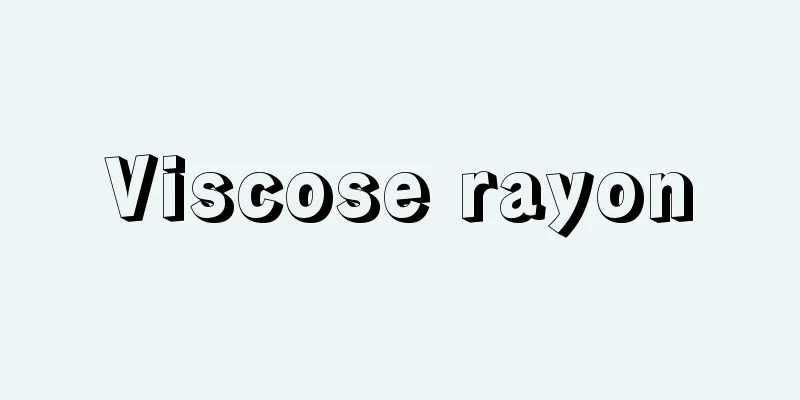Viscose rayon

|
Regenerated cellulose fiber made by spinning viscose that has been chemically treated to disperse and dissolve cellulose. This method was discovered in 1892 by CF Cross and EJ Bevan. The dissolving pulp is soaked in an 18-19% aqueous solution of sodium hydroxide at 18-25°C for about 1-2 hours, and the alkali cellulose is compressed to 2.6-2.8 times its original size. It is then pulverized to increase the reactive surface area. The alkali cellulose molecules are broken by the action of oxygen in the air, and aging is carried out to reduce and adjust the degree of polymerization. This is then reacted with 30-35% carbon disulfide to make sodium cellulose xanthate, which is dissolved by adding a dilute alkali solution to make viscose. To make the viscose suitable for spinning, it is aged (12-20°C), mixed, filtered, degassed, and spun from a spinneret into a coagulation bath consisting of 8-12% sulfuric acid, 13-28% sodium sulfate, and 0-2% zinc sulfate (Muller bath). Cellulose is regenerated under tension. It is then desulfurized, bleached, dried, and made into filaments. Rayon staple is made by bundling many filaments that come out of the spinneret and cutting them to the required length. Viscose rayon is made from hydrated cellulose (cellulose II). It is relatively inexpensive and has good moisture absorption and dyeability, so it is often mixed with other fibers. With slight changes to the manufacturing method, it is used in a wide variety of applications, including polynosic, high-strength rayon for tire cords, strong rayon staple, HWM (High Wet Modulus) rayon, graft copolymer rayon copolymerized with other polymer materials, and mixed spun rayon. Source: Morikita Publishing "Chemical Dictionary (2nd Edition)" Information about the Chemical Dictionary 2nd Edition |
|
セルロースを化学的に処理して,分散,溶解したビスコースを紡糸してつくった再生セルロース繊維.C.F. Cross,E.J. Bevanにより,1892年に見いだされた方法.溶解用パルプを18~19% の水酸化ナトリウム水溶液に18~25 ℃ で約1~2 h 浸し,圧縮倍率2.6~2.8倍にしぼったアルカリセルロースを,反応表面積を増加させるため,粉砕する.ついで空気中の酸素の作用でアルカリセルロース分子を切断し,重合度を低下調整する老成を行う.ついでこれを30~35% の二硫化炭素と反応させ,セルロースキサントゲン酸ナトリウムにして,希アルカリ溶液を加え,溶解し,ビスコースをつくる.さらに紡糸に適したビスコースにするため,熟成(12~20 ℃)し,混合,濾過,脱泡し,紡糸口金より,硫酸8~12%,硫酸ナトリウム13~28%,硫酸亜鉛0~2%(ミュラー浴)よりなる凝固浴中に紡出させる.セルロースが緊張をうけながら再生する.ついで脱硫,漂白などを経て乾燥し,フィラメントにする.レーヨンステープルは紡糸口金から出たフィラメントを多数集束し,必要な長さに切断する.ビスコースレーヨンは水和セルロース(セルロースⅡ)からなる.比較的安価で吸湿性,染色性がよいため,他繊維と混用されることも多い.製造方式を若干変え,ポリノジック,高強力のタイヤコード用強力レーヨン,強力レーヨンステープル,H.W.M.(High Wet Modulus)レーヨン,他の高分子材料を共重合したグラフト共重合レーヨン,混合紡糸レーヨンなどその利用は多岐にわたっている. 出典 森北出版「化学辞典(第2版)」化学辞典 第2版について 情報 |
<<: Visconti - Luchino Visconti (English spelling)
>>: Viscose - Viscose (English spelling)
Recommend
Chaetomium
...The inside of the ascus is hollow, and long, n...
Sulculus diversicolor diversicolor (English spelling) Sulculus diversicolor diversicolor
…[Tadashige Nabe]. . … *Some of the terminology t...
Miyagi [Village] - Miyagi
A village in Seta County, central Gunma Prefecture...
Assistant accountant - Kaikei Shiho
A certified public accountant is a person who assi...
Separations theory
… [Isolation theory] The idea that geographical i...
Kinrobai (Golden dew plum) - Kinrobai (English spelling) hard hack
It is a deciduous shrub of the Rosaceae family tha...
Tea whisk - Chasen
A bamboo whisk used to prepare matcha tea. It is ...
Pasmore, V.
…Among them, Ben Nicholson created his own abstra...
İbrahim Paşa
1493‐1536 Grand vizier (sadorazam) of the Ottoman ...
Cicada - Tanna japonensis
An insect of the Hemiptera family, Cicadaidae (ill...
Jacques-Yves Cousteau
French marine and underwater explorer. Born near ...
Sebottendorf, R.von (English spelling)
…An occult research group founded in Munich in 19...
Intrauterine contraceptive device
…An intrauterine contraceptive device is an abbre...
Picrorhiza
…A perennial plant of the Scrophulariaceae family...
Backfilling - Backfilling
It can also be read as "Gozume." It is a...









